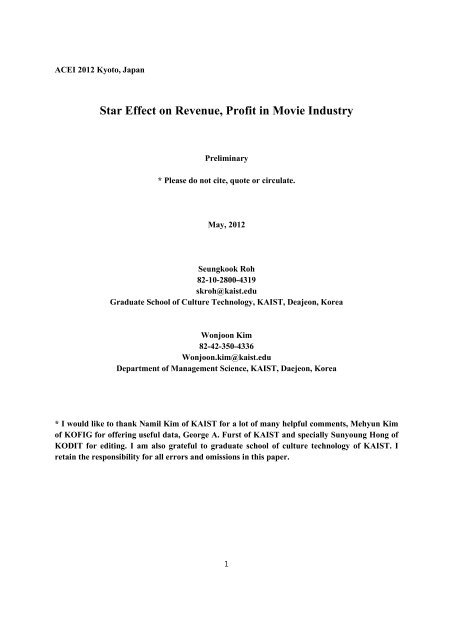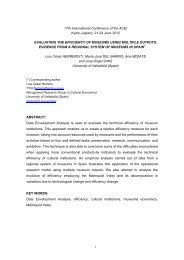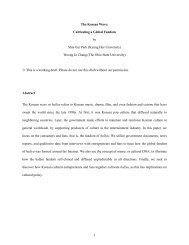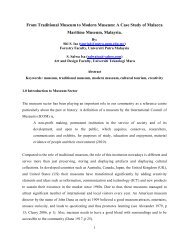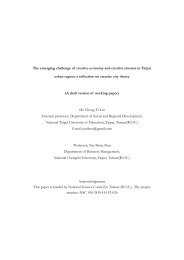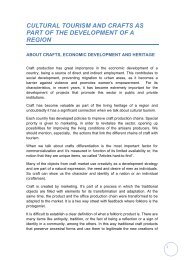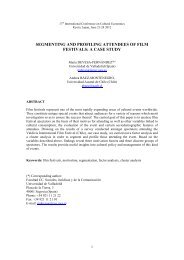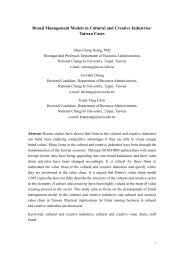Star Effect on Revenue, Profit in Movie Industry
Star Effect on Revenue, Profit in Movie Industry
Star Effect on Revenue, Profit in Movie Industry
Create successful ePaper yourself
Turn your PDF publications into a flip-book with our unique Google optimized e-Paper software.
ACEI 2012 Kyoto, Japan<br />
<str<strong>on</strong>g>Star</str<strong>on</strong>g> <str<strong>on</strong>g>Effect</str<strong>on</strong>g> <strong>on</strong> <strong>Revenue</strong>, <strong>Profit</strong> <strong>in</strong> <strong>Movie</strong> <strong>Industry</strong><br />
Prelim<strong>in</strong>ary<br />
* Please do not cite, quote or circulate.<br />
May, 2012<br />
Seungkook Roh<br />
82-10-2800-4319<br />
skroh@kaist.edu<br />
Graduate School of Culture Technology, KAIST, Deaje<strong>on</strong>, Korea<br />
W<strong>on</strong>jo<strong>on</strong> Kim<br />
82-42-350-4336<br />
W<strong>on</strong>jo<strong>on</strong>.kim@kaist.edu<br />
Department of Management Science, KAIST, Daeje<strong>on</strong>, Korea<br />
* I would like to thank Namil Kim of KAIST for a lot of many helpful comments, Mehyun Kim<br />
of KOFIG for offer<strong>in</strong>g useful data, George A. Furst of KAIST and specially Sunyoung H<strong>on</strong>g of<br />
KODIT for edit<strong>in</strong>g. I am also grateful to graduate school of culture technology of KAIST. I<br />
reta<strong>in</strong> the resp<strong>on</strong>sibility for all errors and omissi<strong>on</strong>s <strong>in</strong> this paper.<br />
1
Abstract<br />
Until now, researchers have studied the methods to forecast f<strong>in</strong>ancial success and bigger<br />
revenues. Am<strong>on</strong>g many success factors, it is still unclear that star effect <strong>on</strong> power has a positive<br />
impact <strong>on</strong> the f<strong>in</strong>ancial performance. This study provides a better framework for predict<strong>in</strong>g f<strong>in</strong>ancial<br />
performance of movies through star power. To solve the current c<strong>on</strong>troversies over star effect <strong>on</strong><br />
revenue and profit, this study focuses <strong>on</strong> revenue as well as profit and compares the star effect <strong>on</strong> each,<br />
separately, by analyz<strong>in</strong>g time-series and cross-secti<strong>on</strong>al movie data. And we f<strong>in</strong>d 1) star effect is<br />
positively associated with revenue, and 2) star effect <strong>in</strong>creases producti<strong>on</strong> costs so that it decreases<br />
profit of movies.<br />
Keywords: <str<strong>on</strong>g>Star</str<strong>on</strong>g>, <str<strong>on</strong>g>Star</str<strong>on</strong>g> power, Moti<strong>on</strong> Picture <strong>Industry</strong>, <strong>Movie</strong> <strong>Industry</strong><br />
2
1. Introducti<strong>on</strong><br />
<strong>Movie</strong>s are the uncerta<strong>in</strong> products to both c<strong>on</strong>sumers and film makers. C<strong>on</strong>sumers do not<br />
know whether it will be a good experience before watch<strong>in</strong>g and enjoy<strong>in</strong>g them(1, 2). Also, no matter<br />
how bad it is, they cannot get movie tickets refunded after a film starts. Similarly, film makers take<br />
c<strong>on</strong>siderable risk s<strong>in</strong>ce the distributi<strong>on</strong> of revenue <strong>in</strong> the movie <strong>in</strong>dustry is highly skewed. An<br />
example is, the top 20% of movies earn approximately 80% of the total revenue <strong>in</strong> the moti<strong>on</strong> picture<br />
<strong>in</strong>dustry(1). Thus, <strong>on</strong>e big hit can offset all the losses due to failures. Because of this unique feature of<br />
the film <strong>in</strong>dustry, many <strong>in</strong>vestors and researchers have tried to f<strong>in</strong>d the critical factors necessary to<br />
make a commercially successful film. Am<strong>on</strong>g the various determ<strong>in</strong>ants, an established audience,<br />
presence of major stars, advertis<strong>in</strong>g, publicity or word-of-mouth and awards have received significant<br />
attenti<strong>on</strong> <strong>in</strong> literature(2, 3). A number of other factors, such as movie genre, critics’ rat<strong>in</strong>gs, MPAA<br />
rat<strong>in</strong>gs and others <strong>in</strong>fluence movie sales as well (1, 2, 4, 5). However, it is still unclear whether star<br />
power has a positive impact <strong>on</strong> the f<strong>in</strong>ancial performance. There have been many approaches for<br />
f<strong>in</strong>d<strong>in</strong>g the relati<strong>on</strong>ship between the success <strong>in</strong> film and star cast<strong>in</strong>g, each <strong>on</strong>e yield<strong>in</strong>g different<br />
results. Some provide evidence that star power has a positive impact <strong>on</strong> revenue (6-10), while others<br />
ma<strong>in</strong>ta<strong>in</strong> that it has no impact <strong>on</strong> box-office performance (2, 11-13). Those who believe <strong>in</strong> the<br />
positive impact of star power are will<strong>in</strong>g to pay milli<strong>on</strong>s of dollars for cast<strong>in</strong>g a super star. In c<strong>on</strong>trast,<br />
those who doubt the effect <strong>in</strong>vest m<strong>on</strong>ey <strong>on</strong> other th<strong>in</strong>gs. Therefore, Hennig-Thuran et al.(2007) also<br />
reviewed that the impact of star power <strong>on</strong> movie success rema<strong>in</strong>s a c<strong>on</strong>tested issue as other<br />
researchers questi<strong>on</strong> this relati<strong>on</strong>ship<br />
Accord<strong>in</strong>gly, the major purpose of this paper is to reexam<strong>in</strong>e the star power <strong>in</strong> the movie<br />
<strong>in</strong>dustry and extend previous research by exam<strong>in</strong><strong>in</strong>g the relati<strong>on</strong>ship between star cast<strong>in</strong>g and revenue<br />
and profit rate. Also, we analyze how revenue and profit rate vary accord<strong>in</strong>g to the magnitude of star<br />
power.<br />
3
The rest of this paper is organized as follows: Secti<strong>on</strong> 2 provides c<strong>on</strong>ceptual background and<br />
hypotheses based <strong>on</strong> a great deal of empirical literature <strong>on</strong> movies. Next, we develop a model to test<br />
these hypotheses and analyze them with data from the Korean film market <strong>in</strong> secti<strong>on</strong> 3. Secti<strong>on</strong> 4<br />
summarizes the result. F<strong>in</strong>ally, secti<strong>on</strong> 5 summarizes overall f<strong>in</strong>d<strong>in</strong>gs gathered through this study and<br />
<strong>in</strong>cludes suggesti<strong>on</strong>s for further research.<br />
4
2. Literature Review <strong>on</strong> <str<strong>on</strong>g>Star</str<strong>on</strong>g> Power of <strong>Movie</strong> <strong>Industry</strong> and Model C<strong>on</strong>structs<br />
In prior research, most authors use "revenue" as a dependent variable when they prove the<br />
relati<strong>on</strong>ship between star power and performance. However, revenues are determ<strong>in</strong>ed by audiences,<br />
profits are determ<strong>in</strong>ed by revenues m<strong>in</strong>us costs(14). That is, high payment for a star guarantees high<br />
expense. For example, Kev<strong>in</strong> Costner’s Water-world which costs $170 milli<strong>on</strong> and earned $88 milli<strong>on</strong><br />
U.S./$166 milli<strong>on</strong> worldwide had a low rate of return(14). As a result, even successful movies do not<br />
always guarantee high net profit after pay<strong>in</strong>g for star guarantee. From a commercial po<strong>in</strong>t of view,<br />
profit rate is a more appropriate variable than revenue for measur<strong>in</strong>g f<strong>in</strong>ancial performance. In the<br />
previous research, S. Albert(1999) menti<strong>on</strong>ed that because of a lack of <strong>in</strong>formati<strong>on</strong> <strong>on</strong> budgets, he<br />
cannot use profits as the measure of success. Therefore it is important to analyze the effect of star<br />
power us<strong>in</strong>g both revenue and profit rate as dependent variables(15). This study presented a positive<br />
relati<strong>on</strong>ship between revenue and star power, but it did not f<strong>in</strong>d a dist<strong>in</strong>ct relati<strong>on</strong>ship between profit<br />
rate and star power. Yet these studies do not sufficiently expla<strong>in</strong> how revenue and profit vary<br />
accord<strong>in</strong>g to the magnitude of star power.<br />
2.1. Positive <str<strong>on</strong>g>Effect</str<strong>on</strong>g> of <str<strong>on</strong>g>Star</str<strong>on</strong>g> Cast<strong>in</strong>g Versus No <str<strong>on</strong>g>Effect</str<strong>on</strong>g> of <str<strong>on</strong>g>Star</str<strong>on</strong>g> Cast<strong>in</strong>g On <strong>Revenue</strong><br />
Many studies provide empirical evidence that star power is significantly related to revenue,<br />
<strong>in</strong> that stars attract more audiences (3, 14, 16-20). Albert studied the role of the star and his model<br />
suggests that stars are significant as they attract a number of fans(14). For this reas<strong>on</strong>, some directors<br />
delay for several years the mak<strong>in</strong>g of a film until a specific actor or actress agrees to jo<strong>in</strong> their movie.<br />
Also, the studies f<strong>in</strong>d that the more famous the actor is, the higher the revenue the movie makes. On<br />
the other hand, other studies <strong>in</strong>dicate that star cast<strong>in</strong>g has no effect <strong>on</strong> revenue (8, 18, 21, 22) and<br />
Ravid(1999) exam<strong>in</strong>ed a signal<strong>in</strong>g model of the role of stars and c<strong>on</strong>cluded that stars play no role <strong>in</strong><br />
the f<strong>in</strong>ancial success of a film(15). For example, movies such as the Jaws, <str<strong>on</strong>g>Star</str<strong>on</strong>g> Wars, Titanic, Shrek<br />
were the biggest box office hits without a super star. Furthermore, Avatar recently released <strong>in</strong><br />
Hollywood, and several Korean movies such as Friend (2001), K<strong>in</strong>g and the Clown (2005), Old<br />
5
Partner (2008) support the f<strong>in</strong>d<strong>in</strong>g that revenue is not associated with the <strong>in</strong>volvement of famous<br />
actors. Also, Elberse(2007) cannot f<strong>in</strong>d evidence of c<strong>on</strong>tributi<strong>on</strong>s of stars to movie success through<br />
the <strong>on</strong>l<strong>in</strong>e fantasy HSX market(9). This <strong>in</strong>formati<strong>on</strong> is summarized <strong>in</strong> Table 1. In other words, some<br />
movies without famous actors were not a success, and several movies featur<strong>in</strong>g well-known stars were<br />
also not commercially successful. However, although a film is a big failure at the box office,<br />
c<strong>on</strong>tracted salaries of stars and product costs cannot be reduced or collected. Therefore, it is obvious<br />
that a big budget for cast<strong>in</strong>g famous actors or actress may have a negative effect <strong>on</strong> ec<strong>on</strong>omic<br />
performance, given that star power is <strong>in</strong>significant to draw audience. We thus propose the first set of<br />
hypotheses:<br />
Table 1. Literature source Related to Positive and Negative <str<strong>on</strong>g>Effect</str<strong>on</strong>g> of <str<strong>on</strong>g>Star</str<strong>on</strong>g> Power <strong>on</strong> <strong>Movie</strong> <strong>Industry</strong><br />
Researcher<br />
Positive No effect<br />
Rosen, 1981<br />
Prag and Casavant, 1994<br />
De Vany, 1999, 2004<br />
Kelwick, 2002<br />
Elberse, 2007<br />
H1: A star power <strong>in</strong>fluences positively movie’s revenue.<br />
2.2. <str<strong>on</strong>g>Star</str<strong>on</strong>g> Cast<strong>in</strong>g and <strong>Profit</strong> Rate<br />
6<br />
Ravid, 1999, 2004<br />
Shugan, 2004<br />
A<strong>in</strong>slie, 2005<br />
Brewer, 2009<br />
No matter how big the revenue, no <strong>in</strong>vestors want to provide m<strong>on</strong>ey to make films for which<br />
net profits are zero. Certa<strong>in</strong>ly, they want to receive a high percentage of return <strong>on</strong> <strong>in</strong>vestment.<br />
However, immoderate and careless budget cuts for cast<strong>in</strong>g could cause a falloff <strong>in</strong> the quality of the<br />
film. The reputati<strong>on</strong> and popularity of a star actor generally reflects their superb act<strong>in</strong>g skills known<br />
from <strong>in</strong> previous films(8). Many award w<strong>in</strong>n<strong>in</strong>g films have high producti<strong>on</strong> costs, which seem to<br />
<strong>in</strong>dicate that high negative cost is attributed to the high quality of the film(2, 23). That is, negative<br />
cost and market<strong>in</strong>g cost for film mak<strong>in</strong>g ‘pays off’ for maximizati<strong>on</strong> of profits(8). In this c<strong>on</strong>text, the<br />
effect of star cast<strong>in</strong>g should be analyzed for profit rate, not revenue, when the quality of the movie
and commercial success are c<strong>on</strong>sidered. S<strong>in</strong>ce the direct measure of net profit after deduct<strong>in</strong>g every<br />
cost from revenue is difficult to obta<strong>in</strong>, various studies evaluate ec<strong>on</strong>omic performance, focus<strong>in</strong>g <strong>on</strong><br />
revenue rather than net profit. However, if the payment for cast<strong>in</strong>g stars is more costly than the m<strong>on</strong>ey<br />
amount that the stars draw and receive from sales of movie tickets, it would be doubtful to say that the<br />
movie is successful. For this reas<strong>on</strong>, Ravid(1999) used profit rate <strong>in</strong>stead of revenue to assess the<br />
effect of star cast<strong>in</strong>g <strong>in</strong> relati<strong>on</strong> to ec<strong>on</strong>omic performance of the movie. Ravid reports that revenue is<br />
not c<strong>on</strong>sistent with profit rate due to the different amount of payment for cast<strong>in</strong>g. As shown <strong>in</strong> the<br />
scatter diagram below Figure 1, empirical data collected <strong>in</strong> this study also show that higher revenue<br />
does not always guarantee high profit rate.<br />
PR<br />
0 .2 .4 .6 .8 1<br />
0 5 10 15<br />
LNREV<br />
Figure 1. Relati<strong>on</strong>ship between <strong>Revenue</strong> and <strong>Profit</strong> rate<br />
Data <strong>in</strong> this study Table 2 also shows that revenue is <strong>in</strong>significantly related with profit rate.<br />
Table 2. Correlati<strong>on</strong> between <strong>Revenue</strong> and <strong>Profit</strong> rate<br />
<strong>Profit</strong> Rate <strong>Revenue</strong><br />
<strong>Profit</strong> Rate 1.0000 -<br />
<strong>Revenue</strong> 0.377 1.0000<br />
*Correlati<strong>on</strong> is significant at the 0.01 level (2-tailed)<br />
7
Ravid suggested that high expense for mak<strong>in</strong>g films generates high revenue, but it does not<br />
always <strong>in</strong>crease profit rate(1, 15). Therefore, it is desirable to analyze revenue and profit rate <strong>in</strong><br />
relati<strong>on</strong> with the <strong>in</strong>fluence of star power.<br />
Based <strong>on</strong> these discussi<strong>on</strong>s, we have the follow<strong>in</strong>g hypotheses:<br />
H2: A star power <strong>in</strong>fluences negatively movie’s profit.<br />
8
3. Methodology<br />
3.1. Data<br />
In this study, data was collected from the Korean Film Council (KOFIC) and NAVER <strong>Movie</strong>,<br />
a popular Korean search portal. The sample c<strong>on</strong>sists of 214 films out of the 349 Korean films released<br />
dur<strong>in</strong>g 2008-2010. We removed 135 movies with life-cycle less than four weeks <strong>in</strong> theatres s<strong>in</strong>ce <strong>on</strong><br />
average the revenue of the movies dur<strong>in</strong>g the first four weeks account for more than 90% of their total<br />
revenue(24). In additi<strong>on</strong>, each of 214 films has their own daily WOM, the open<strong>in</strong>g number of screen,<br />
revenue and profit rate for 28 days. Thus, the total amount of data becomes 5,992.<br />
Specifically, the primary source of data for star, movie rat<strong>in</strong>g[G, under 12(similar to PG13),<br />
15(similar to R), or 18(similar to R)] by the Korea Media Rat<strong>in</strong>g Board(KMRB) like Moti<strong>on</strong> Picture<br />
Associati<strong>on</strong> of America(MPAA) rat<strong>in</strong>g <strong>in</strong> United States of America, release date of movies (weekday<br />
or weekend), distributor (major or m<strong>in</strong>or), producer (major or m<strong>in</strong>or), and volume of Word-Of-Mouth<br />
(WOM) about volume and critical review is the NAVER <strong>Movie</strong> site (http://movie.naver.com)(5).<br />
NAVER, as the most popular portal <strong>in</strong> Korea, surpasses any other portal sites such as Google and<br />
Yahoo <strong>in</strong> market share, thus it helps decrease bias <strong>in</strong> the demographic compositi<strong>on</strong> of the Web site’s<br />
visitors. Also, revenue, profit rate and WOM volume are archived and <strong>in</strong>dexed numerically by the<br />
dates, so it is easy to collect data. The negative expense and market<strong>in</strong>g expense data are both collected<br />
from articles, movie public relati<strong>on</strong>s (PR) <strong>in</strong>formati<strong>on</strong> and papers offered from KOFIC. The data<br />
regard<strong>in</strong>g the number of screens <strong>in</strong> the theater is collected from annual report and official web-site of<br />
KOFIC.<br />
3.2. Variables<br />
3.2.1. Dependent Variables<br />
Dependent variables <strong>in</strong> this study c<strong>on</strong>sist of two variables which are revenue and profit rate.<br />
Each variable has same <strong>in</strong>dependent variables to compare with <strong>on</strong>e another c<strong>on</strong>cern<strong>in</strong>g a star effect.<br />
9
3.2.2. <strong>Revenue</strong><br />
<strong>Revenue</strong> is a good <strong>in</strong>dicator to assess ec<strong>on</strong>omic performance s<strong>in</strong>ce it c<strong>on</strong>ta<strong>in</strong>s not <strong>on</strong>ly box-<br />
office gross but also <strong>in</strong>come through other distributi<strong>on</strong> channels, so-called “w<strong>in</strong>dow effect” (e.g.<br />
release <strong>in</strong> foreign market, DVD, pay televisi<strong>on</strong> etc.)(1). Thus, revenue has been used as a dependent<br />
variable <strong>in</strong> the earlier studies. However, the w<strong>in</strong>dow effect <strong>in</strong> Korean film <strong>in</strong>dustry is <strong>in</strong>significant. 88%<br />
of revenue earned from box-office receipt <strong>in</strong> 2009, and the percentage of revenue from sales of theatre<br />
tickets has been <strong>in</strong>creas<strong>in</strong>g s<strong>in</strong>ce the year 2000. In comparis<strong>on</strong> with other countries, widely circulated<br />
illegal download of movies and pirated copies impede the growth of home video market (VHS, DVD),<br />
rema<strong>in</strong><strong>in</strong>g <strong>in</strong> 0.86% of total revenue <strong>in</strong> movie <strong>in</strong>dustry as of 2009. Also, exports to foreign markets<br />
tend to be <strong>in</strong>creas<strong>in</strong>g, but it reached about 4.12% <strong>in</strong> 2009 (KOFIC, 2009). For this reas<strong>on</strong>, revenue <strong>in</strong><br />
this study is c<strong>on</strong>f<strong>in</strong>ed to the box office receipt, the total amount of m<strong>on</strong>ey from the sale of tickets for<br />
movie.<br />
3.2.3. <strong>Profit</strong> rate<br />
Ravid(1999) def<strong>in</strong>ed that profit rate is the return <strong>on</strong> <strong>in</strong>vestment measure, total revenues<br />
divided by the negative cost(15). Here, negative cost is a producti<strong>on</strong> cost for f<strong>in</strong>al film, <strong>in</strong>clud<strong>in</strong>g<br />
actors’ salaries, film<strong>in</strong>g costs edit<strong>in</strong>g costs etc. Negative cost shows a highly positive correlati<strong>on</strong> with<br />
star cast<strong>in</strong>g s<strong>in</strong>ce negative cost <strong>in</strong>cludes star cast<strong>in</strong>g(22). Also, negative cost is positively related to<br />
revenue(2).<br />
3.2.4. Independent Variables<br />
In this study, <strong>in</strong>dependent variables c<strong>on</strong>sist<strong>in</strong>g of several variables are used <strong>in</strong> many previous<br />
research to analyze the correlati<strong>on</strong> with the commercial performance of movie.<br />
3.2.5. <str<strong>on</strong>g>Star</str<strong>on</strong>g> Power<br />
10
In the previous studies, the star power variable was used to expla<strong>in</strong> box office success.<br />
Moreover, “<str<strong>on</strong>g>Star</str<strong>on</strong>g>s are a l<strong>on</strong>g-stand<strong>in</strong>g feature of the movie bus<strong>in</strong>ess and the top <strong>on</strong>es command large<br />
salaries”(25). However, it has always been difficult to def<strong>in</strong>e star power. So, many different<br />
approaches to measure star power have been adopted from review<strong>in</strong>g the actor’s box office history,<br />
their movie award records and so <strong>on</strong>(25, 26). Am<strong>on</strong>g many methods, we adopted Elberse’s method to<br />
measure star power. This is based <strong>on</strong> the numbers of audience for the most recent years. That assesses<br />
star power quantitatively <strong>in</strong> each movie based <strong>on</strong> the performance <strong>in</strong> previous films.<br />
3.2.6. Other variables<br />
Except for star power, we adopted genre, movie rat<strong>in</strong>g, weekend, distributor, producer, the<br />
open<strong>in</strong>g number of Screen, word of mouth (WOM), critical review as c<strong>on</strong>trol variables <strong>in</strong> this study (2,<br />
3, 5, 8, 9, 18, 27-32). Moreover, am<strong>on</strong>g the variables menti<strong>on</strong>ed above, we c<strong>on</strong>verted revenue, the<br />
open<strong>in</strong>g number of screens, WOM, star power <strong>in</strong>to logged form as these variables are logged due to<br />
their ‘l<strong>on</strong>g right-tailed nature’(2, 33).<br />
Table 3. Descriptive Statistics of this research<br />
Variable Mean Std. Dev. M<strong>in</strong> Max<br />
Dependent Variables<br />
LNREV 7.069745 3.400228 0 13.39704<br />
PR 0.01304 0.031892 0 0.907299<br />
Independent Variables<br />
LNSCR 3.494642 2.140678 0 6.714171<br />
LNWOM 2.218691 2.078476 0 7.489971<br />
day 14.5 8.078421 1 28<br />
weekend 0.428571 0.494913 0 1<br />
Distributor 0.453271 0.497853 0 1<br />
producer 0.070094 0.255326 0 1<br />
R12 0.242991 0.428925 0 1<br />
R15 0.378505 0.485055 0 1<br />
11
3.3. Model<br />
R18 0.252336 0.43439 0 1<br />
GA 0.046729 0.211075 0 1<br />
GT 0.140187 0.34721 0 1<br />
GM 0.126168 0.332067 0 1<br />
GD 0.35514 0.478596 0 1<br />
GH 0.046729 0.211075 0 1<br />
LNSTAR 9.834363 5.959906 0 19.79363<br />
CR 7.567383 1.39874 2.6 10<br />
Even though a lot of authors have studied the impact of star power as <strong>on</strong>e of several factors<br />
<strong>on</strong> movie success discussed <strong>in</strong> the previous research, these were ma<strong>in</strong>ly d<strong>on</strong>e through multiple<br />
regressi<strong>on</strong> analysis us<strong>in</strong>g cross-secti<strong>on</strong>al data (8, 15, 18, 20, 21). However, movie data has to be<br />
analyzed by time-series and cross-secti<strong>on</strong> together because new movies <strong>in</strong>fluences their revenue and<br />
profit rate are statistically dependent each other at the given time. Thus, We estimate that the<br />
relati<strong>on</strong>ship between revenue and star us<strong>in</strong>g Panel regressi<strong>on</strong> which is usually carried out <strong>on</strong> Time-<br />
Series Cross-Secti<strong>on</strong>al data that has observati<strong>on</strong>s over time for several different units or ‘cross-<br />
secti<strong>on</strong>s’(34). In additi<strong>on</strong>, this data has heteroskedasticity <strong>in</strong> error term. Thus, we used a Generalized<br />
Least Squares (GLS) method to calculate effective estimates. We developed two empirical models to<br />
test star power <strong>in</strong>fluence <strong>on</strong> revenue and profit rate as follows:<br />
3.3.1. Relati<strong>on</strong>ship between <strong>Revenue</strong> and <str<strong>on</strong>g>Star</str<strong>on</strong>g><br />
In the first model, we c<strong>on</strong>sidered an estimated panel model for daily box office revenue,<br />
<strong>in</strong>clud<strong>in</strong>g Table 4 to def<strong>in</strong>e variables, is as follows:<br />
(�) ����� �� = ����� + � ������ �� + � ��� �� + � ���� �� �� + � ������� � + � �� �<br />
+ � �� � + � �� � + � �� � + � �� � + � ��<br />
12
Table 4. Variables Utilized <strong>in</strong> Above Equati<strong>on</strong><br />
Variable Descripti<strong>on</strong> of measure<br />
LNREV Daily <strong>Revenue</strong><br />
LNSCR Daily open<strong>in</strong>g number of each movie’s screens for 28 days<br />
CR Critical review<br />
LNWOM Daily WOM volume for 28 days<br />
LNSTAR Actor’s box office history for last 3years<br />
R <strong>Movie</strong> rat<strong>in</strong>g (Rate 12, Rate 15, Rate 18)<br />
W Weekend (Dummy variable, weekday 0, weekend 1)<br />
G Genre dummy (Comedy 0, Acti<strong>on</strong>, Thriller 1, Melodrama 2, Drama 3, Horror 4,<br />
Others 5(SF, Animati<strong>on</strong>, Documentary etc.)<br />
D Distributor dummy (Major distributor 1, M<strong>in</strong>or distributor 0)<br />
P Producer dummy (Major producer 1, M<strong>in</strong>or producer 0)<br />
Where t stand<strong>in</strong>g for each day is (1,2,…28) and i stand<strong>in</strong>g for each movie is (1,2,… 214). The model<br />
is composed of daily open<strong>in</strong>g number of each movie’s screens for 28 days, critical review, daily<br />
WOM volume for 28 days, star effect, movie rat<strong>in</strong>g dummy, weekend, and genre dummy, distributor<br />
dummy, and producer dummy.<br />
3.3.2. Relati<strong>on</strong>ship between <strong>Profit</strong> Rate and <str<strong>on</strong>g>Star</str<strong>on</strong>g><br />
In the sec<strong>on</strong>d model, we estimate that the relati<strong>on</strong>ship between profit rate and star us<strong>in</strong>g<br />
panel analysis. The estimated panel model for daily box office revenue, <strong>in</strong>clud<strong>in</strong>g Table 5 to def<strong>in</strong>e<br />
variables, is as follows:<br />
(�) �� �� = ����� + � ������ �� + � ��� �� + � ���� �� �� + � ������� � + � �� � + � �� �<br />
+ � �� � + � �� � + � �� � + � ��<br />
Table 5. Variables Utilized <strong>in</strong> Above Equati<strong>on</strong><br />
Variable Descripti<strong>on</strong> of measure<br />
PR <strong>Profit</strong> Rate<br />
LNSCR Daily open<strong>in</strong>g number of each movie’s screens for 28 days<br />
CR Critical review<br />
LNWOM Daily WOM volume<br />
LNSTAR Actor’s box office history for last 3years<br />
13
R Prohibiti<strong>on</strong> code dummy (Rate 12, Rate 15, Rate 18)<br />
W Weekend (Dummy variable, weekday 0, weekend 1)<br />
G Genre dummy (Comedy 0, Acti<strong>on</strong>, Thriller 1, Melodrama 2, Drama 3, Horror 4,<br />
Others 5(SF, Animati<strong>on</strong>, Documentary etc.)<br />
D Distributor dummy (Major distributor 1, M<strong>in</strong>or distributor 0)<br />
P Producer dummy (Major producer 1, M<strong>in</strong>or producer 0)<br />
Where t stand<strong>in</strong>g for each day is (1,2,…28) and i stand<strong>in</strong>g for each movie is (1,2,… 214). The model<br />
is composed of daily open<strong>in</strong>g number of each movie’s screens for 28 days, critical review, daily<br />
WOM volume for 28 days, star effect, movie rat<strong>in</strong>g dummy, weekend, and genre dummy, distributor<br />
dummy, and producer dummy.<br />
14
4. Results and Discussi<strong>on</strong>s<br />
4.1. <strong>Revenue</strong> and <str<strong>on</strong>g>Star</str<strong>on</strong>g><br />
Table 6 summarizes the estimated empirical relati<strong>on</strong>ship between explanatory variables and<br />
box office revenue. <str<strong>on</strong>g>Star</str<strong>on</strong>g> power, the number of open<strong>in</strong>g screens, WOM, Distributor and critical rat<strong>in</strong>gs<br />
are all positively related to revenue. Also, the empirical result <strong>in</strong>dicates that Drama Genre generate<br />
higher revenue than movies rated as R12, R15. However, producer, R18 and Genre (acti<strong>on</strong>, Thriller,<br />
melodrama, horror) are not significantly associated with revenue. As for genre, comedy films draw<br />
more audience than other genres.<br />
Table 6: Determ<strong>in</strong>ants of <strong>Revenue</strong><br />
Dependent Variable: Log(<strong>Revenue</strong>), N=5,992<br />
Panel Analysis (Random-effects Generalized Least Squares regressi<strong>on</strong>)<br />
Variable Coef. Std. Err. z P>Z<br />
LN<str<strong>on</strong>g>Star</str<strong>on</strong>g> 0.007521* 0.002839 2.65 0.008<br />
LNSCR 1.233673* 0.01119 110.25 0<br />
LNWOM 0.324035* 0.010905 29.71 0<br />
weekend 0.460477* 0.023889 19.28 0<br />
Distributor 0.097941* 0.030826 3.18 0.001<br />
producer 0.021941 0.048853 0.45 0.653<br />
R12 -0.19515* 0.042877 -4.55 0<br />
R15 -0.21239* 0.043779 -4.85 0<br />
R18 -0.07825 0.049049 -1.6 0.111<br />
GA -0.07131 0.062192 -1.15 0.252<br />
GT -0.04353 0.044947 -0.97 0.333<br />
GM -0.1205* 0.043889 -2.75 0.006<br />
GD -0.20517* 0.031826 -6.45 0<br />
GH -0.26863* 0.061593 -4.36 0<br />
CR 0.127408* 0.009584 13.29 0<br />
CONST 1.015788 0.092077 11.03 0<br />
Notes: <strong>in</strong>dicate the significance at 1% level *, 5% level **, panels: homoscedastic, no autocorrelati<strong>on</strong><br />
As shown <strong>in</strong> table 6, this empirical study presents that star power is positively associated<br />
with revenue (H1). This f<strong>in</strong>d<strong>in</strong>g is equivalent to previous study regard<strong>in</strong>g Hollywood movies(28).<br />
Regardless of quality and producti<strong>on</strong> cost of the movie, moviegoers pay the same price for buy<strong>in</strong>g<br />
15
tickets. Thus, moviegoers are more likely to choose the movies with a variety of attracti<strong>on</strong>s and<br />
popularity such as well-known stars, directors, and state-of-the-art 3D technology <strong>in</strong> order to decrease<br />
the likelihood of failure(2). For this reas<strong>on</strong>, theatres show several marketable movies. This<br />
m<strong>on</strong>opoly of the screen limited the selecti<strong>on</strong> of audience and <strong>in</strong> turn movies with well-known stars<br />
become box-office success. Thus, the movie <strong>in</strong>dustry has about 0.8 of G<strong>in</strong>i’s coefficient and is<br />
therefore regarded as highly dangerous and uncerta<strong>in</strong>.<br />
4.2. <strong>Profit</strong> Rate and <str<strong>on</strong>g>Star</str<strong>on</strong>g><br />
Table 7 describes <strong>in</strong>dependent variables which <strong>in</strong>fluence profit rate. Variables such as<br />
number of screens, WOM, weekend, and critical rat<strong>in</strong>gs are all positively related with profit rate.<br />
However, star power, distributor, producer are negatively correlated with profit rate. Also, films rated<br />
under G-rated movies generate higher profit than films rated R12. It is assumed that the genre of films<br />
rated G are generally family drama, documentary, comedy, which produce movies with relatively<br />
lower budget and therefor result <strong>in</strong> a higher profit rate. However, <strong>in</strong> the previous research regard<strong>in</strong>g<br />
movie rat<strong>in</strong>gs <strong>in</strong> Hollywood, G-rated and over R18 (R-rated <strong>in</strong> U.S.) movies have nearly equal<br />
average rates of return. The reas<strong>on</strong> of the difference of two movie markets resulted from a cultural<br />
dist<strong>in</strong>cti<strong>on</strong> of mak<strong>in</strong>g R-rated movies each country. Usually R-rated movies are low-budget movies <strong>in</strong><br />
Hollywood while R-rated movies are middle or high-budget movies for adults <strong>in</strong> Korea. However,<br />
R18 and horror movie are not significantly associated with revenue. As for genre, comedy films draw<br />
more profitable than other genres.<br />
Table 7. <strong>Profit</strong> Rate and Independent Variables<br />
Dependent Variable: Log(<strong>Revenue</strong>), N=5,992<br />
Panel Analysis (Random-effects Generalized Least Squares regressi<strong>on</strong>)<br />
Variable Coef. Std. Err. z P>z<br />
LN<str<strong>on</strong>g>Star</str<strong>on</strong>g> -0.00083* 8.81E-05 -9.43 0<br />
LNSCR 0.002658* 0.000347 7.65 0<br />
LNWOM 0.005268* 0.000339 15.56 0<br />
16
Weekend 0.008253* 0.000742 11.13 0<br />
Distributor -0.00586* 0.000957 -6.12 0<br />
Producer -0.00302** 0.001517 -1.99 0.046<br />
R12 -0.00907* 0.001331 -6.81 0<br />
R15 -0.00454* 0.001359 -3.34 0.001<br />
R18 -0.00257 0.001523 -1.69 0.091<br />
GA -0.00382** 0.001931 -1.98 0.048<br />
GT -0.00589* 0.001395 -4.22 0<br />
GM -0.00332** 0.001362 -2.44 0.015<br />
GD -0.00772* 0.000988 -7.81 0<br />
GH -0.00188 0.001912 -0.98 0.326<br />
CR 0.002503* 0.000298 8.41 0<br />
CONST -0.01055 0.002858 -3.69 0<br />
Notes: <strong>in</strong>dicate the significance at 1% level *, 5% level **, Panels: homoscedastic, no<br />
autocorrelati<strong>on</strong><br />
17
5. C<strong>on</strong>clusi<strong>on</strong> and future research<br />
In the movie <strong>in</strong>dustry, profit rate as well as revenue is important for estimat<strong>in</strong>g ultimate<br />
commercial success. Thus, this study compares star power with revenue and profit rate. We propose<br />
two hypotheses: (1) stars <strong>in</strong>fluence positively revenue and (2) stars <strong>in</strong>fluence negatively profit rate.<br />
This study exam<strong>in</strong>ed the determ<strong>in</strong>ants of revenue and profit rate of Korean films for the years 2008-<br />
2010. The revenue dur<strong>in</strong>g these years shows a positive relati<strong>on</strong>ship with star power. On the other hand,<br />
the profit rate shows an opposite result, which is high <strong>in</strong> a low level of star power and low <strong>in</strong> the high<br />
level of star power. These results support that producers and <strong>in</strong>vestors need to c<strong>on</strong>sider star power to<br />
make profitable movies <strong>in</strong> Hollywood. It would be not a good strategy to spend budgets for actors<br />
with star power related to profit rate. In future research, we will extend our study to Hollywood<br />
films and films of other countries to obta<strong>in</strong> a more universal c<strong>on</strong>clusi<strong>on</strong>.<br />
18
Reference<br />
1. J. Eliashberg, A. Elberse, M. A. A. M. Leenders, The moti<strong>on</strong> picture <strong>in</strong>dustry: Critical issues<br />
<strong>in</strong> practice, current research, and new research directi<strong>on</strong>s. Market<strong>in</strong>g Science, 638 (2006).<br />
2. S. M. Brewer, J. M. Kelley, J. J. Jozefowicz, A bluepr<strong>in</strong>t for success <strong>in</strong> the US film <strong>in</strong>dustry.<br />
Applied Ec<strong>on</strong>omics 41, 589 (2009).<br />
3. J. Kelwick. (Retrieved September from http://www. kelwick. karoo. net/<strong>in</strong>dex. htm, 2002).<br />
4. W. Duan, B. Gu, A. B. Wh<strong>in</strong>st<strong>on</strong>, The dynamics of <strong>on</strong>l<strong>in</strong>e word-of-mouth and product sales<br />
- An empirical <strong>in</strong>vestigati<strong>on</strong> of the movie <strong>in</strong>dustry. J Retail<strong>in</strong>g 84, 233 (2008).<br />
5. J. Yang, W. Kim, N. Amblee, J. Je<strong>on</strong>g, The Heterogeneous <str<strong>on</strong>g>Effect</str<strong>on</strong>g> of WOM <strong>on</strong> Product Sales:<br />
Why the <str<strong>on</strong>g>Effect</str<strong>on</strong>g> of WOM Valence is Mixed? , (2011).<br />
6. S. Rosen, The ec<strong>on</strong>omics of superstars. The American ec<strong>on</strong>omic review 71, 845 (1981).<br />
7. A. S. De Vany, W. D. Walls, Moti<strong>on</strong> picture profit, the stable Paretian hypothesis, and the<br />
curse of the superstar. Journal of Ec<strong>on</strong>omic Dynamics and C<strong>on</strong>trol 28, 1035 (2004).<br />
8. J. Prag, J. Casavant, An empirical study of the determ<strong>in</strong>ants of revenues and market<strong>in</strong>g<br />
expenditures <strong>in</strong> the moti<strong>on</strong> picture <strong>in</strong>dustry. Journal of Cultural Ec<strong>on</strong>omics 18, 217 (1994).<br />
9. A. Elberse, The power of stars: Do star actors drive the success of movies? J Market<strong>in</strong>g 71,<br />
102 (2007).<br />
10. A. De Vany, W. D. Walls, Uncerta<strong>in</strong>ty <strong>in</strong> the movie <strong>in</strong>dustry: Does star power reduce the<br />
terror of the box office? Journal of Cultural Ec<strong>on</strong>omics 23, 285 (1999).<br />
11. S. A. Ravid, Are they all crazy or just risk averse? Some movie puzzles and possible<br />
soluti<strong>on</strong>s. C<strong>on</strong>tributi<strong>on</strong>s to ec<strong>on</strong>omic analysis 260, 33 (2004).<br />
12. A. A<strong>in</strong>slie, X. Drèze, F. Zufryden, Model<strong>in</strong>g movie life cycles and market share. Market<strong>in</strong>g<br />
Science, 508 (2005).<br />
13. T. Hennig-Thurau, M. B. Houst<strong>on</strong>, G. Walsh, Determ<strong>in</strong>ants of moti<strong>on</strong> picture box office and<br />
profitability: an <strong>in</strong>terrelati<strong>on</strong>ship approach. Review of Managerial Science 1, 65 (2007).<br />
14. S. Albert, <strong>Movie</strong> <str<strong>on</strong>g>Star</str<strong>on</strong>g>s and the Distributi<strong>on</strong> of F<strong>in</strong>ancially Successful Films <strong>in</strong> the Moti<strong>on</strong><br />
Picture <strong>Industry</strong>. Journal of Cultural Ec<strong>on</strong>omics 23, 325 (1999).<br />
15. S. A. Ravid, Informati<strong>on</strong>, Blockbusters, and <str<strong>on</strong>g>Star</str<strong>on</strong>g>s: A Study of the Film <strong>Industry</strong>*. The Journal<br />
of Bus<strong>in</strong>ess 72, 463 (1999).<br />
16. S. Basuroy, S. Chatterjee, S. A. Ravid, How critical are critical reviews? The box office effects<br />
of film critics, star power, and budgets. J Market<strong>in</strong>g, 103 (2003).<br />
17. M. B. Holbrook, C<strong>on</strong>sumer value: a framework for analysis and research. (Psychology<br />
Press, 1999).<br />
18. B. R. Litman, Predict<strong>in</strong>g success of theatrical movies: An empirical study. The Journal of<br />
Popular Culture 16, 159 (1983).<br />
19. R. Neelamegham, P. Ch<strong>in</strong>tagunta, A Bayesian model to forecast new product performance<br />
19
<strong>in</strong> domestic and <strong>in</strong>ternati<strong>on</strong>al markets. Market<strong>in</strong>g Science, 115 (1999).<br />
20. S. Sochay, Predict<strong>in</strong>g the performance of moti<strong>on</strong> pictures. J Media Ec<strong>on</strong> 7, 1 (1994).<br />
21. S. P. Smith, V. K. Smith, Successful movies: A prelim<strong>in</strong>ary empirical analysis. Applied<br />
Ec<strong>on</strong>omics 18, 501 (1986).<br />
22. S. M. Shugan, Editorial: Endogeneity <strong>in</strong> market<strong>in</strong>g decisi<strong>on</strong> models. Market<strong>in</strong>g Science, 1<br />
(2004).<br />
23. D. K. Sim<strong>on</strong>t<strong>on</strong>, C<strong>in</strong>ematic creativity and aesthetics: Empirical analyses of movie awards.<br />
New directi<strong>on</strong>s <strong>in</strong> aesthetics, creativity, and the arts, 123 (2006).<br />
24. L. Q<strong>in</strong>, WORD-OF-BLOG FOR MOVIES: A PREDICTOR AND AN OUTCOME OF BOX OFFICE<br />
REVENUE? Journal of Electr<strong>on</strong>ic Commerce Research 12, (2011).<br />
25. J. McKenzie, The ec<strong>on</strong>omics of movies: A literature survey. Journal of Ec<strong>on</strong>omic Surveys,<br />
(2012).<br />
26. A. Coll<strong>in</strong>s, C. Hand, M. C. Snell, What makes a blockbuster? Ec<strong>on</strong>omic analysis of film<br />
success <strong>in</strong> the United K<strong>in</strong>gdom. Managerial and Decisi<strong>on</strong> Ec<strong>on</strong>omics 23, 343 (2002).<br />
27. A. De Vany, W. Walls, Big budgets, big open<strong>in</strong>gs and legs: Analysis of the blockbuster<br />
strategy. Asian Ec<strong>on</strong>omic Review 47, 308 (2004).<br />
28. A. De Vany, W. D. Walls, Does Hollywood Make Too Many R-Rated <strong>Movie</strong>s? Risk, Stochastic<br />
Dom<strong>in</strong>ance, and the Illusi<strong>on</strong> of Expectati<strong>on</strong>*. The Journal of Bus<strong>in</strong>ess 75, 425 (2002).<br />
29. E. Agliari, R. Buri<strong>on</strong>i, D. Cassi, F. M. Neri, Word-of-mouth and dynamical <strong>in</strong>homogeneous<br />
markets: an efficiency measure and optimal sampl<strong>in</strong>g policies for the pre-launch stage.<br />
Ima J Manag Math 21, 67 (Jan, 2010).<br />
30. I. Ahn, M. Suom<strong>in</strong>en, Word-of-mouth communicati<strong>on</strong> and community enforcement. Int<br />
Ec<strong>on</strong> Rev 42, 399 (May, 2001).<br />
31. D. T. Allsop, B. R. Bassett, J. A. Hosk<strong>in</strong>s, Word-of-mouth research: Pr<strong>in</strong>ciples and<br />
applicati<strong>on</strong>s. J Advertis<strong>in</strong>g Res 47, 398 (Dec, 2007).<br />
32. P. U. Nyer, M. Gop<strong>in</strong>ath, <str<strong>on</strong>g>Effect</str<strong>on</strong>g>s of compla<strong>in</strong><strong>in</strong>g versus negative word of mouth <strong>on</strong><br />
subsequent changes <strong>in</strong> satisfacti<strong>on</strong>, the role of public commitment. Psychol Market 22,<br />
937 (Dec, 2005).<br />
33. J. S. Sim<strong>on</strong>off, I. R. Sparrow, Predict<strong>in</strong>g movie grosses: W<strong>in</strong>ners and losers, blockbusters<br />
and sleepers. CHANCE-BERLIN THEN NEW YORK- 13, 15 (2000).<br />
34. J. A. Stims<strong>on</strong>, Regressi<strong>on</strong> <strong>in</strong> space and time: A statistical essay. American Journal of Political<br />
Science, 914 (1985).<br />
35. R. Echambadi, J. D. Hess, Mean-center<strong>in</strong>g does not alleviate coll<strong>in</strong>earity problems <strong>in</strong><br />
moderated multiple regressi<strong>on</strong> models. Market<strong>in</strong>g Science 26, 438 (2007).<br />
36. J. D. Kromrey, L. Foster-Johns<strong>on</strong>, Mean center<strong>in</strong>g <strong>in</strong> moderated multiple regressi<strong>on</strong>: Much<br />
ado about noth<strong>in</strong>g. Educati<strong>on</strong>al and Psychological Measurement 58, 42 (1998).<br />
20


